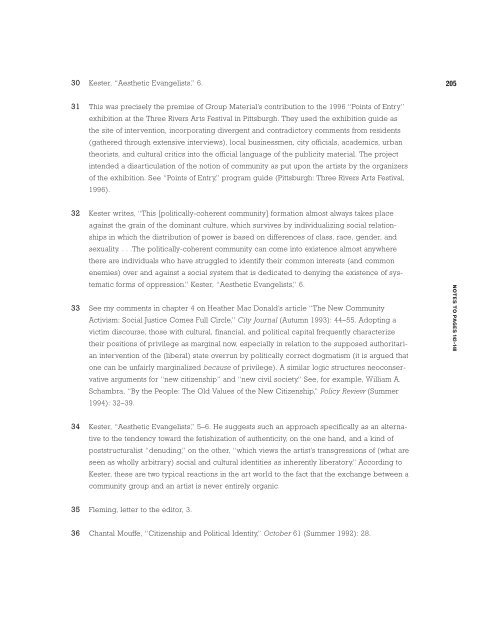ONE PLACE AFTER ANOTHER - Monoskop
ONE PLACE AFTER ANOTHER - Monoskop
ONE PLACE AFTER ANOTHER - Monoskop
You also want an ePaper? Increase the reach of your titles
YUMPU automatically turns print PDFs into web optimized ePapers that Google loves.
30 Kester, “Aesthetic Evangelists,” 6.<br />
31 This was precisely the premise of Group Material’s contribution to the 1996 “Points of Entry”<br />
exhibition at the Three Rivers Arts Festival in Pittsburgh. They used the exhibition guide as<br />
the site of intervention, incorporating divergent and contradictory comments from residents<br />
(gathered through extensive interviews), local businessmen, city officials, academics, urban<br />
theorists, and cultural critics into the official language of the publicity material. The project<br />
intended a disarticulation of the notion of community as put upon the artists by the organizers<br />
of the exhibition. See “Points of Entry,” program guide (Pittsburgh: Three Rivers Arts Festival,<br />
1996).<br />
32 Kester writes, “This [politically-coherent community] formation almost always takes place<br />
against the grain of the dominant culture, which survives by individualizing social relationships<br />
in which the distribution of power is based on differences of class, race, gender, and<br />
sexuality. ...The politically-coherent community can come into existence almost anywhere<br />
there are individuals who have struggled to identify their common interests (and common<br />
enemies) over and against a social system that is dedicated to denying the existence of systematic<br />
forms of oppression.” Kester, “Aesthetic Evangelists,” 6.<br />
33 See my comments in chapter 4 on Heather Mac Donald’s article “The New Community<br />
Activism: Social Justice Comes Full Circle,” City Journal (Autumn 1993): 44–55. Adopting a<br />
victim discourse, those with cultural, financial, and political capital frequently characterize<br />
their positions of privilege as marginal now, especially in relation to the supposed authoritarian<br />
intervention of the (liberal) state overrun by politically correct dogmatism (it is argued that<br />
one can be unfairly marginalized because of privilege). A similar logic structures neoconser-<br />
vative arguments for “new citizenship” and “new civil society.” See, for example, William A.<br />
Schambra, “By the People: The Old Values of the New Citizenship,” Policy Review (Summer<br />
1994): 32–39.<br />
34 Kester, “Aesthetic Evangelists,” 5–6. He suggests such an approach specifically as an alterna-<br />
tive to the tendency toward the fetishization of authenticity, on the one hand, and a kind of<br />
poststructuralist “denuding,” on the other, “which views the artist’s transgressions of (what are<br />
seen as wholly arbitrary) social and cultural identities as inherently liberatory.” According to<br />
Kester, these are two typical reactions in the art world to the fact that the exchange between a<br />
community group and an artist is never entirely organic.<br />
35 Fleming, letter to the editor, 3.<br />
36 Chantal Mouffe, “Citizenship and Political Identity,” October 61 (Summer 1992): 28.<br />
205<br />
NOTES TO PAGES 142–148

















